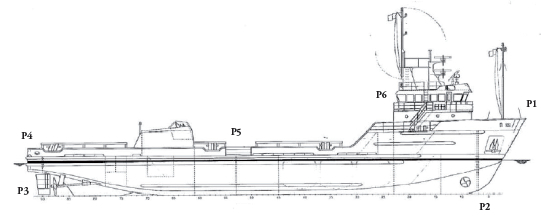Analysis of Operational and Seakeeping aspects in the Design of PSV type for the Colombian Caribbean Sea
DOI:
https://doi.org/10.25043/19098642.140Keywords:
Offshore Operations, Seeakeeping, PSVAbstract
Colombia is currently searching for oil and gas at sea as new exploratory frontiers so as to incorporate new reserves. With the beginning of maritime operations comes the need for large offshore structures that allow the extraction and separation of oil and gas before transporting it to land. Most of these platforms require specific support and supply vessels, carrying a variety of loads, from liquid and bulk up general cargo, and various specific activities such as towing, rescue staff in case of accidents, firefighting and positioning anchor handling. In the offshore industry, these are known as PSV (Platform Supply Vessels). e main purpose of this work is the hydrodynamic PSV considering the environmental and operational conditions of the Colombian Caribbean including a case study.
Downloads
References
BRETCHNEIDER C.L. Wave variability and Wave spectra for windgenerated gravity waves. Tech memo No. 118 CERC USA. (1959)
BHATTACHARRYY, R. Dynamics of Marine Vehicles. Edition xx. John Wiley & Sons, Inc, 508 P. 1978
CIOH, OCEANOGRAFIA OPERACIONAL. Oleaje del mar Caribe, [web on-line]. Available at: http://www.cioh.org.co/meteorologia/CaribWan2.php, January 31, 2015.
GUTIERREZ. GUSTAVO ADOLFO. Estudio de la evolución temporal del espectro de ola bajo condiciones atmosféricas severas, [web on-line]. Available at: http://www.academia.edu/6129678/An%C3%ADa_de_oleaje_bajo_condiciones_atmosf%C3%A9ricas_severas_en_el_Carible_Colombiano, recovered: June 14-17, 2005.
GRAHAM, R. "Motion-Induced Interruptions as Ship Operability Criteria," Naval Engineers Journal, pp.65-71, March 1990.
GRIFFIN, M. J. Sea sickness. AGARD Conference on Motion Sickness. 1984.
GRIFFIN, M. J. Physical Characteristics of stimuli provoking motion sickness. AGARD Conference on Motion Sickness. AGARD Conference on Motion Sickness. 1984.
HASSEMAN, K., and BARUETT, T.P. and others: "Measurements of wind wave growth and swelt decay during the Jonswap". Deustche Hidro. Zeitschirft, Reilie A (8.º). No. 12, 1973.
Más inversiones petroleras. Carta petrolera. (113). 5 P. 2005
MORALES, O. Diseño hidrodinámico de embarcaciones de apoyo offshore para el Caribe colombiano. Colombia. Fecha. 40 diapositivas, col.
NEUMANN. G.:"On ocean wave spectra and a new method of forecasting wind generated sea". Tech. Mem. No. 43. Beach Erosion Board. Corps f Engineers. Washintong D.C.1953.
International Standards Organization. Mechanical vibration and shock- Evaluation of human exposure to whole-bodyvibraton-Part 1: General requirements. ISO 2631-1: 1997 standard.1997
O´HANLON, J.F y MccAULEY, M.E. Motion sickness incidence as a function of frequency and accelertion of vertical sinusoidal motion. Aerospace Medicine, 45. 1974.
RAWSON, K. J. Basic Ship Theory. Edition 5. Butterworth.Heinemann.784p. 2001. ISBN 9780750653985.
Seakeeper user manual, formation design system. 2007.
ST DENIS, M, AND PIERSON, W.J. On the motions of ships in confused seas. Transactions of the Society of Naval Achitects an Marine Engineers. 1953.
Tayrona, el foco principal. Carta petrolera.

Published
How to Cite
Issue
Section
License
The authors who publish in this Journal certify that:
- The work submitted for publication in The Ship Science and Technology journal, was written by the author, given that its content is the product of his/her direct intellectual contribution.
- All data and references to material already published are duly identified with their respective credits and are included in the bibliographic notes and quotations highlighted as such.
- All materials submitted for publication are completely free of copyrights; consequently, the author accepts responsibility for any lawsuit or claim related with Intellectual Property Rights thereof, Exonerating of responsibility to The Science and Technology for the Development of Naval, Maritime, and Riverine Industry Corporation, COTECMAR.
- In the event that the article is chosen for publication by The Ship Science and Technology journal, the author state that he/she totally transfers reproduction rights of such to The Science and Technology for the Development of Naval, Maritime, and Riverine Industry Corporation, COTECMAR.
- The authors retain the copyright and transfer to COTECMAR the right of publication and reproduction of the work which will be simultaneously subject to the Creative Commons Attribution License (CC -BY) , which allows the license to copy, distribute, display and represent the work and to make derivative works as long as it recognizes and cites the work in the manner specified by the author or licensor.
- For more information about the Creative Commons Attribution License (CC -BY) and his use and scope, please visit the following web page https://creativecommons.org/licenses/by-sa/4.0/legalcode








